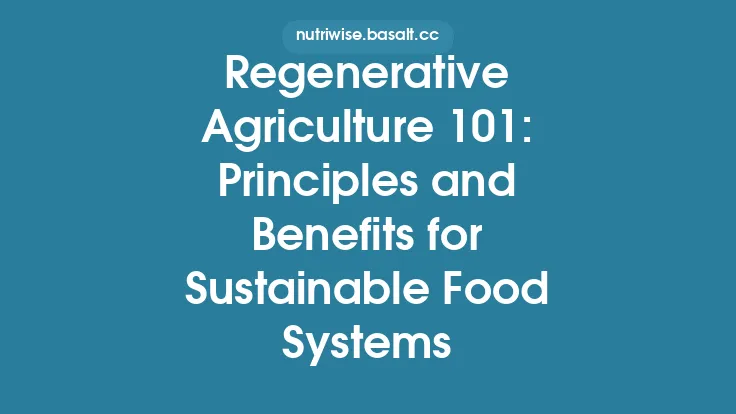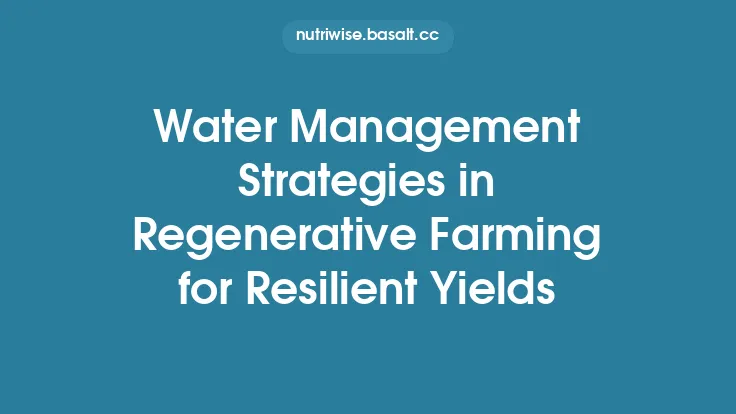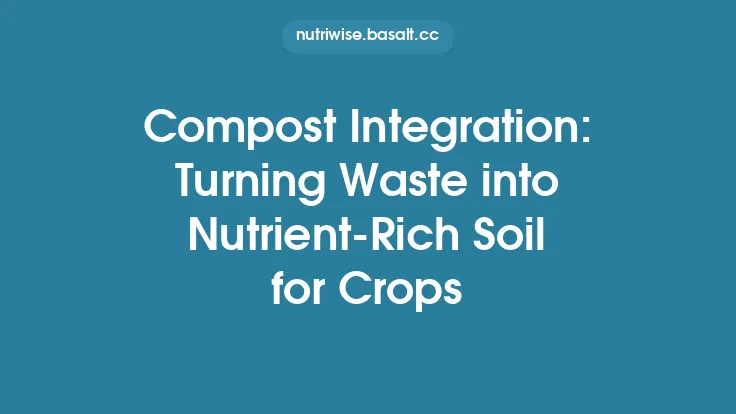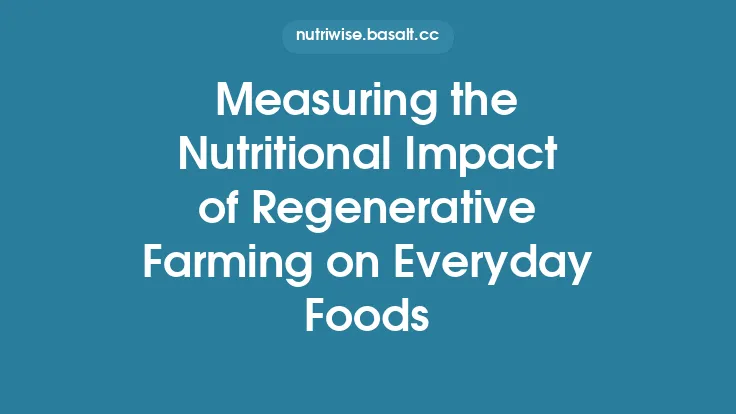The practice of rotating crops is one of the oldest and most powerful tools in the farmer’s toolbox, yet its relevance has never been greater. In a world where synthetic fertilizers are increasingly scrutinized for their environmental footprint, regenerative crop rotations offer a pathway to sustain—and even enhance—soil fertility using the ecosystem’s own processes. By deliberately sequencing plant species over time, growers can tap into natural nutrient cycles, build organic matter, and create a resilient soil environment that supports healthy plant growth without relying on external chemical inputs.
Why Crop Rotations Are Central to Regenerative Agriculture
Crop rotation is more than a simple change of scenery for the field; it is a strategic manipulation of biological, chemical, and physical soil processes. Each plant species has a distinct root architecture, exudate profile, and nutrient demand. When these species are rotated, they collectively:
- Balance Nutrient Extraction and Replenishment – Heavy‑feeding crops (e.g., corn) are followed by species that either fix atmospheric nitrogen or have lower nutrient requirements, preventing the depletion of key elements.
- Disrupt Pest and Disease Cycles – Many soil‑borne pathogens and insect pests are host‑specific. Rotating away from a host interrupts their life cycles, reducing the need for chemical controls.
- Stimulate Soil Biota – Diverse root exudates feed a broader spectrum of microbes, fungi, and nematodes, fostering a robust soil food web that drives nutrient mineralization.
- Improve Physical Structure – Varied root depths and architectures create channels for water infiltration and aeration, enhancing aggregate stability and reducing compaction.
These outcomes align directly with the regenerative goal of restoring soil health, making rotation a cornerstone of any system that seeks to minimize synthetic inputs.
Core Principles of Effective Rotations
- Diversity Over Uniformity
A rotation that includes at least three distinct functional groups—cereals, legumes, and root or leafy crops—creates the most balanced nutrient and pest management outcomes. The greater the taxonomic and functional diversity, the more resilient the system.
- Temporal Complementarity
Align crop phenology with seasonal climate patterns. Early‑season cool‑weather crops (e.g., barley) can be followed by warm‑season heat‑tolerant species (e.g., sorghum), ensuring that each plant exploits the optimal window for growth and nutrient uptake.
- Spatial Complementarity
Within a field, consider sub‑zones that receive different rotations based on micro‑soil variations (e.g., low‑lying, moisture‑retentive areas vs. well‑drained ridges). This “strip‑rotation” approach maximizes the use of site‑specific conditions.
- Nutrient Budgeting
Treat the field as a closed nutrient loop. Quantify the nitrogen, phosphorus, potassium, and micronutrient removal of each crop and plan subsequent crops that either replenish those nutrients or have lower removal rates.
- Root Depth Stratification
Alternate deep‑rooted crops (e.g., alfalfa, winter wheat) with shallow‑rooted species (e.g., lettuce, radish). Deep roots draw nutrients from subsoil layers and deposit organic matter deeper, while shallow roots protect topsoil from erosion and promote surface organic inputs.
Designing Multi‑Year Rotation Plans
A well‑crafted rotation is typically plotted over a 4‑ to 6‑year horizon, allowing sufficient time for each functional group to exert its benefits. Below is a representative six‑year plan for a temperate region:
| Year | Primary Crop | Functional Role | Key Soil Benefits |
|---|---|---|---|
| 1 | Winter Wheat | Cereal (high N demand) | Establishes a dense root mat, scavenges residual nitrate |
| 2 | Soybean | Legume (N‑fixer) | Biological nitrogen fixation, adds organic N to soil |
| 3 | Tillage‑Free Oats | Cereal (moderate N demand) | Provides ground cover, improves soil structure |
| 4 | Hairy Vetch (green manure) | Cover/legume | Rapid N fixation, biomass for mulch |
| 5 | Radish–Turnip Mix | Root/leafy (shallow root) | Bio‑drill for compaction, adds organic matter |
| 6 | Barley (early‑season) | Cereal (low N demand) | Early canopy reduces erosion, prepares for next cycle |
Key design considerations:
- Incorporate a “break crop” every 2–3 years—typically a legume or a low‑nutrient‑demand cereal—to reset nutrient balances.
- Plan for residue management: Crops that leave high‑quality residues (e.g., legumes) should be positioned before a high‑nutrient‑demanding crop to maximize mineralization.
- Flexibility: Weather anomalies may force a deviation from the plan; maintain a decision matrix that allows substitution without breaking the functional sequence.
Leveraging Legumes for Biological Nitrogen Fixation
Legumes are the linchpin of nitrogen‑free fertility strategies. Their symbiotic relationship with rhizobia bacteria converts atmospheric N₂ into plant‑available ammonium. To maximize this benefit:
- Select high‑fixing varieties: Certain cultivars (e.g., ‘Pioneer 93B15’ soybean) have been bred for superior nodulation.
- Inoculate seed with the appropriate rhizobial strain, especially when rotating into new fields where native rhizobia populations may be low.
- Manage soil pH: Rhizobia thrive in a pH range of 6.0–7.0; liming may be necessary if soils are acidic.
- Avoid excessive nitrogen: High residual nitrate from previous synthetic applications can suppress nodulation, reducing the legume’s fixing capacity.
When legumes are followed by a nitrogen‑hungry cereal, the residual nitrogen released during residue decomposition can meet a substantial portion of the cereal’s nitrogen requirement, often reducing synthetic fertilizer needs by 30–70 %.
Incorporating Green Manures and Catch Crops
Green manures are fast‑growing, non‑harvested crops that are terminated and incorporated into the soil to add organic matter and nutrients. While they overlap with cover crops, the focus here is on their role within a rotation rather than the broader ecological services covered in a dedicated cover‑crop article.
- Timing of Termination: Ideally, terminate the green manure at the early flowering stage to maximize nitrogen content while minimizing lignin, which slows decomposition.
- Biomass Targets: Aim for 4–6 t ha⁻¹ of dry matter for temperate climates; higher biomass translates to greater carbon inputs and nutrient release.
- Species Selection: Choose species that complement the preceding and succeeding crops. For example, a winter rye green manure after a summer legume can capture residual nitrogen and prevent leaching.
Managing Soil Structure and Organic Matter
Soil structure is the physical framework that determines water movement, root penetration, and gas exchange. Rotations influence structure through:
- Root Channel Formation: Deep‑rooted crops create macropores that persist after root decay, improving aeration and drainage.
- Organic Matter Accumulation: Diverse residues contribute a range of carbon compounds (cellulose, hemicellulose, lignin) that, when decomposed, form stable humus fractions.
- Aggregate Stabilization: Fungal hyphae, especially from mycorrhizal associations, act as biological glues, binding soil particles into stable aggregates.
A practical metric for monitoring progress is the soil organic carbon (SOC) stock. Incremental gains of 0.2–0.5 % per year are achievable with well‑designed rotations, translating into measurable improvements in water holding capacity and nutrient retention.
Enhancing Soil Microbial Communities
Microbial diversity underpins nutrient cycling. Rotations shape microbial assemblages by varying:
- Root Exudate Chemistry: Different crops release distinct sugars, organic acids, and secondary metabolites, selecting for specific bacterial and fungal groups.
- Residue Quality: High‑C/N residues (e.g., wheat straw) favor fungi, while low‑C/N residues (e.g., legume residues) promote bacterial activity.
To foster a thriving microbiome:
- Avoid Broad‑Spectrum Biocides: Limit the use of non‑selective fungicides and herbicides that can harm beneficial microbes.
- Maintain Continuous Living Roots: Even during fallow periods, planting a low‑input “living mulch” (e.g., clover) keeps the rhizosphere active.
- Inoculate with Beneficial Consortia: Commercial mycorrhizal inoculants can accelerate colonization, especially after a period of intensive tillage.
Pest and Disease Suppression Through Diversity
Many soil‑borne pathogens, such as Fusarium spp. or Rhizoctonia, specialize on particular host families. By rotating out of a host for at least two consecutive seasons, pathogen inoculum levels decline dramatically. Similarly, insect pests that overwinter in crop residues are disrupted when non‑host residues are introduced.
Strategic tactics:
- Rotate Within Plant Families: Avoid planting two cereals (e.g., wheat → barley) back‑to‑back; instead, insert a legume or root crop.
- Use “Trap Crops”: Plant a susceptible variety for a single season to draw pests away from the main cash crop, then destroy the trap crop before pest reproduction.
- Integrate Biological Controls: Encourage predatory nematodes and entomopathogenic fungi by providing habitat through residue retention and diverse rotations.
Integrating Livestock and Crop Rotations (Without Replicating Holistic Grazing)
While holistic grazing is a distinct discipline, modest livestock integration can amplify the benefits of rotation without requiring a full grazing system. Practices include:
- Cover Crop Grazing: After a cover crop has terminated, a small herd of cattle or sheep can graze the biomass, returning manure directly to the field and reducing the need for external fertilization.
- Manure Application Timing: Align livestock grazing periods with the early growth stage of the subsequent crop, allowing manure nutrients to be incorporated as the crop establishes.
- Rotational Stocking: Move livestock between fields on a schedule that mirrors the crop rotation, ensuring that each field receives a balanced nutrient input over the rotation cycle.
These approaches add a source of organic nitrogen and stimulate microbial activity through the addition of fresh organic matter.
Monitoring and Adapting Rotation Performance
A regenerative rotation is a dynamic system; regular monitoring ensures that goals are being met and allows for timely adjustments.
- Soil Testing: Conduct comprehensive soil analyses every 2–3 years, focusing on macro‑nutrient levels, pH, SOC, and micronutrient status.
- Residue Quality Assessment: Use the C:N ratio as a quick indicator of decomposition speed; ratios around 20–30 : 1 are optimal for rapid mineralization.
- Yield Tracking: Compare yields across rotation phases to identify any nutrient deficits or pest pressures that may require intervention.
- Biological Indicators: Soil respiration rates, microbial biomass carbon, and mycorrhizal colonization percentages provide insight into biological health.
When data reveal a trend—e.g., declining nitrogen after consecutive cereals—adjust the rotation by inserting a legume or green manure earlier than planned.
Case Studies and Practical Implementation
Midwestern United States – Corn‑Soybean‑Winter Wheat Loop
Farmers in Iowa have replaced a traditional corn‑only system with a three‑year rotation: corn → soybean → winter wheat. Over five years, they reported a 25 % reduction in synthetic nitrogen fertilizer use, a 15 % increase in soil organic carbon, and comparable corn yields to the previous monoculture.
Southern Spain – Cereal‑Legume‑Root Crop Sequence
In the semi‑arid zones of Andalusia, a rotation of barley → chickpea → radish has been adopted. The chickpea legume supplies nitrogen for the subsequent barley, while the radish’s deep taproots break up compacted subsoil layers, improving water infiltration. Soil tests showed a 0.3 % rise in SOC after three cycles, and pest pressure from cereal aphids dropped by 40 % due to the interruption of host availability.
Australian Grain Belt – Multi‑Crop Strip Rotation
A grain farm in New South Wales implemented a strip‑rotation where adjacent 0.5‑ha strips followed different sequences (e.g., wheat‑vetch‑canola vs. barley‑lentil‑sorghum). This spatial diversification reduced disease incidence of Septoria leaf blotch by 60 % across the field, while overall grain quality improved due to more balanced nutrient uptake.
These examples illustrate that, regardless of climate or scale, thoughtful rotation design can deliver tangible fertility gains without synthetic inputs.
By weaving together diverse crops, strategic timing, and a keen eye on soil biology, regenerative crop rotations become a self‑sustaining engine of fertility. The result is a resilient agro‑ecosystem that produces abundant food, safeguards the environment, and reduces reliance on external chemical inputs—fulfilling the core promise of regenerative agriculture.





